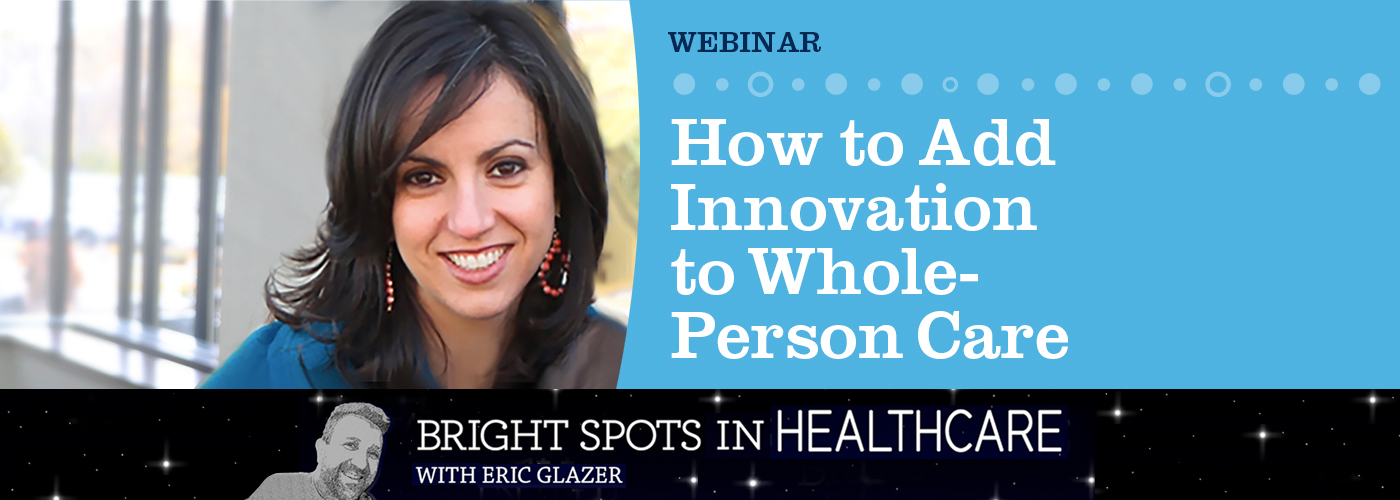
Last week, I had the opportunity to participate in Bright Spots in Healthcare’s webinar, “How to Add Innovation to Whole-Person Care” hosted by Eric Glazer. I was honored to join Angela Lynn, Director of Care Management for Blue Cross and Blue Shield of North Carolina, Laurie Gehrt, Department Vice President, care management of Blue Cross and Blue Shield of Kansas City, and Amy Bloomquist, Director of Population Health Design for Blue Cross and Blue Shield of Minnesota. Together, we discussed how each of our organizations is addressing whole-person care and how this closer examination of the social, environmental, and behavioral factors impacting health has led to improved health outcomes and lower costs.
According to the National Institutes of Health, “whole-person health involves looking at the whole person—not just separate organs or body systems—and considering multiple factors that promote either health or disease. It means helping and empowering individuals, families, communities, and populations to improve their health in multiple interconnected biological, behavioral, social, and environmental areas. Instead of treating a specific disease, whole-person health focuses on restoring health, promoting resilience, and preventing diseases across a lifespan.”
I noticed a common theme in our discussion, which emphasized that a highly personalized approach is key to the efficacy of clinical programs. I’ve seen this firsthand as a clinical pharmacist and was eager to discuss the role of comprehensive medication management in whole-person care. For example, we often hear about the rising cost of prescription drugs, but not about the cost of non-optimized medication use–estimated as the cause for 16% of health care costs. At MOBE, we shift the focus from medication adherence to addressing how someone’s health status, environment, lifestyle or access issues are impacting their health outcomes achievement from, and continued need for, medications.
Looking broadly at MOBE’s approach, we start by using multi-factorial analytics to identify people who aren’t engaged in preventive care or wellness programs. Instead of looking at single chronic conditions, we find patterns of use that indicate a need for support. Then we connect people with personal lifestyle coaches to help improve and support an individual’s self-efficacy toward behavior change related to diet, physical activity, sleep, and stress management, as well as with clinical pharmacists to examine medication management. Not only does this one-to-one support help people connect the dots between lifestyle and health, it also makes improved health outcomes more attainable and sustainable.
The most promising aspect of whole-person care is that the opportunities for innovation are endless. I’m amazed by the great work being done across our industry every day and was honored to join a panel of leaders sharing their valuable advancements and approaches.
Angela explained how Blue Cross and Blue Shield of North Carolina is using artificial intelligence to identify a member’s “social vulnerability index” which examines factors including a member’s medication adherence, behavioral health data and their access to care. Once that data is provided to the care team, they’re able to tailor interventions to meet member needs and improve health outcomes for those at highest risk.
Amy discussed the important role of doulas in achieving better outcomes for pregnant people and their babies, especially in the Black, Indigenous and People of Color (BIPOC) community, as they are at greater risk for complications due to health inequities and structural racism. She remarked how Blue Cross and Blue Shield of Minnesota is offering scholarships and advocating for higher doula wages, correcting misinformation regarding the role and capabilities of a doula, as well as increasing the number of BIPOC doulas to reflect the community they support.
Laurie provided an example of how Blue Cross and Blue Shield of Kansas City (BCBSKC) is identifying members who are using the emergency room as a replacement to primary care, and matching members with personas to find which they are most likely to identify and engage with. She shared a powerful story of a young, pregnant woman with chronic conditions that put her and her baby at risk of complications. Once BCBSKC aligned social work, OBGYN, and community health teams, they were able to reach the member at the hospital and come up with a holistic plan that prevented her from needing readmittance until she successfully delivered her baby.
Whether discussing chronic kidney disease, pregnancy, or diabetes, all of the clinical conditions we spoke about are highly affected by what else is going on in an individual’s life. When we address these other factors and treat them holistically, we see how whole-person health improves a person’s health outcomes and lowers costs across the health system.
Click here to watch the webinar, “How to Add Innovation to Whole-Person Care.”